| << |20 | 21 |
1 | 2 | 3 | 4 | 5
Portugal, Adventure #26, Page 1
Pictures and Stories About Bicycle Adventures
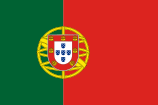
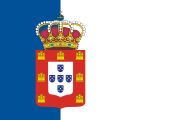 Portugal's
Portugal'sDouro River Valley
By Bicicleta (Bicycle), Septembre, 2009
Itinerary
- Arrive at Lisbon, Visit 6 Days (Conference 4 Days)
- Tour West Coast, Central, Viseu, Dao Region, 2 Days
- Train to Pinhão, Bicycle Self Guided Tour Douro River Valley, 6 Days
- Train from Pocinho to Porto, Depart Porto, 2 Days
Forgive my Americano Keyboard; it does not have Acute, Tilde, or Circumflex accent options.
These characters must be hard coded with strings of special code - it takes extra effort.
Pinhão is coded as Pinhão, with proud extra effort by the Author.
FYI, the ão sound in Portuguese is pronounced as 'ow.n' in English and
the oa sound in Portuguese (Lisboa) is pronounced as 'on' (Lisbon).
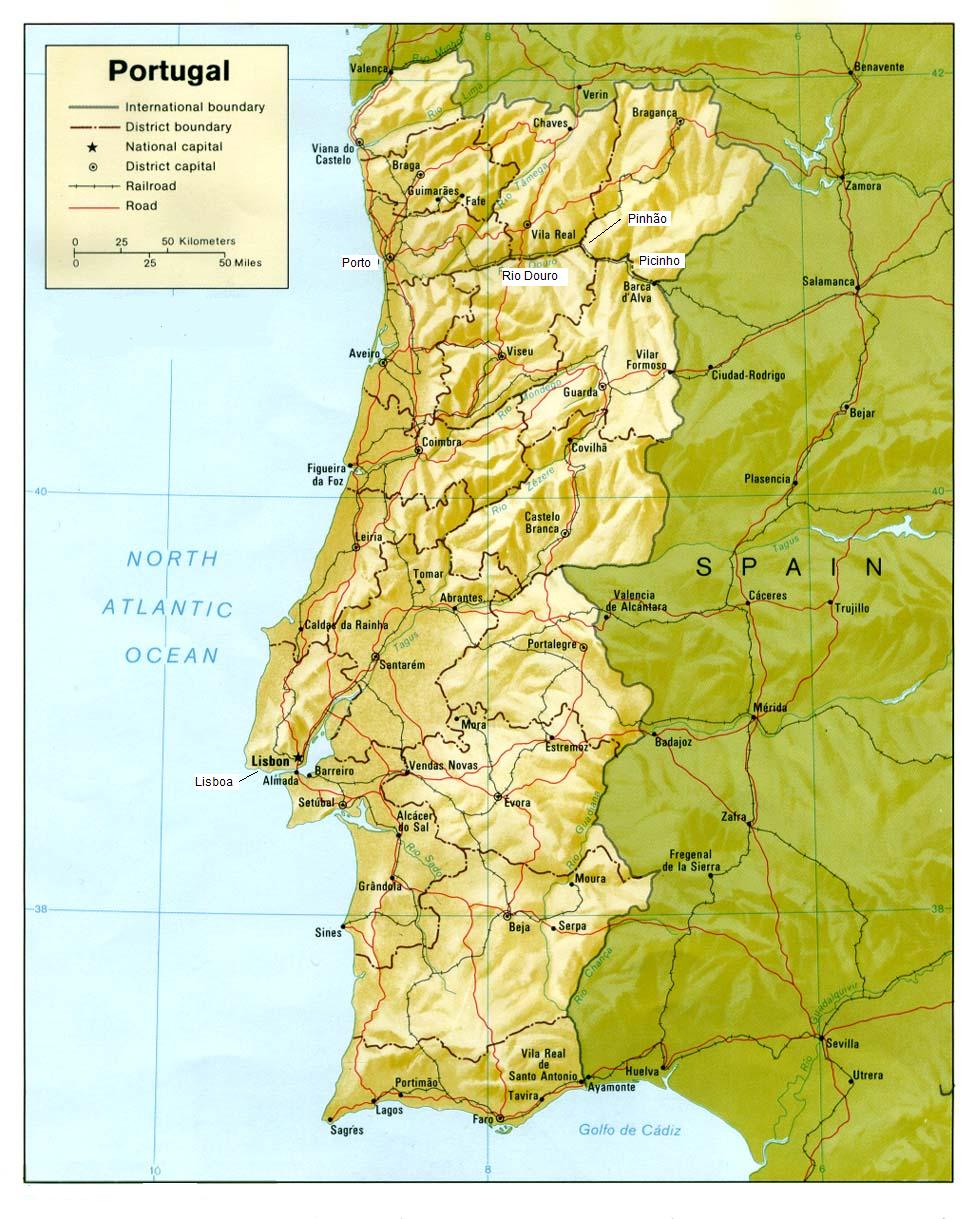
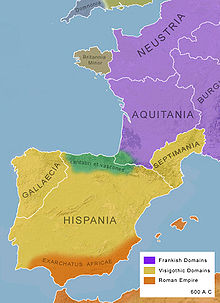
Cool Facts and Observations
Food
Mass Transportation
The Knights Templar and Portugal
Facts: Poor Fellow-Soldiers of Christ and of the Temple of Solomon (Latin: Pauperes commilitones Christi Templique Solomonici), commonly known as the Knights Templar or the Order of the Temple (French: Ordre du Temple or Templiers). Source: WikipediaAfter King Philip IV of France started his purge of Templars (1307), many escaped to Portugal. They were immediately accepted by King Denis (of the House of Burgundy, King of Portugal and the Algarves 1279-1325, Son of Afonso III of Portugal and Beatrice of Castile) for several reasons. One, King Denis knew King Philip's charges to be false and Templar confessions to be under duress (torture), but the Pope (Clement) literally resided in France at the time so the Pope had to be careful and did issue the Papal Bull to arrest all Templars and seize their assets. King Denis petitioned the Pope to allow Templars outside of France to not be persecuted and to even maintain their holdings. This petition was finally approved (long after all holdings were taken). Meanwhile, the Templars had money and skills as masons, shipwrights, sailors, and soldiers. All of which King Denis put to use. Important Note: Templar Masons built simple and practical structures using late gothic conventions - It appears that Templar Masons have nothing to do with Freemasons and vice versa, except that some Freemasons have used some Templar symbols and some Templar names [many myths here].
Knights Templar:
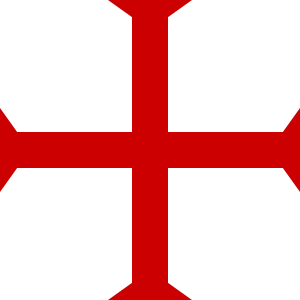 Knights of Christ:
Knights of Christ:
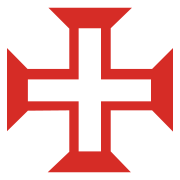 Portugal:
Portugal:
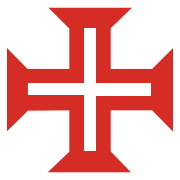
The Knights Templar organization, already well established in Portugal, upon persecution by King Philip IV of France simply changed their name from Knights Templar to Knights of Christ. One of the larger Templar holdings in Portugal is the Convent of Christ in Castle Tomar. Built in 1160 as a stronghold for the Knights Templar, it became the headquarters of the renamed Order of Christ (Portugal), often called or referred to as "the Order". One of the lesser known facts about the Knights Templar is that they had a small fleet of ocean going Ships [18 known], mainly used for cargo, transport, and high speed messaging that saw service from the Mediterranean to France and England. They also had inland river boats. At one point, the Templars owned the island of Cyprus.
Royal Emblem(s)
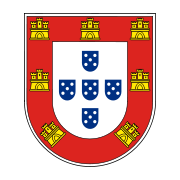 The Shield of the House of Burgundy has always been a variation of a blue cross. Later variations show five smaller shield shapes arranged in a cross pattern, the shields themselves containing five white circles or squares. Later, the Portuguese Burgundy's added a ring of castles around the Shield of Burgundy to symbolize the organized action of Portuguese Houses to retake Portugal from the Muslim Occupiers. The number of castles has varied, but the latest version has seven castles, supposedly for the seven major strongholds and engagements to retake Portugal from the Muslims. The displayed shield emblem is more or less the emblem in the current Portuguese National Flag.
The Shield of the House of Burgundy has always been a variation of a blue cross. Later variations show five smaller shield shapes arranged in a cross pattern, the shields themselves containing five white circles or squares. Later, the Portuguese Burgundy's added a ring of castles around the Shield of Burgundy to symbolize the organized action of Portuguese Houses to retake Portugal from the Muslim Occupiers. The number of castles has varied, but the latest version has seven castles, supposedly for the seven major strongholds and engagements to retake Portugal from the Muslims. The displayed shield emblem is more or less the emblem in the current Portuguese National Flag.
The Armillary Sphere
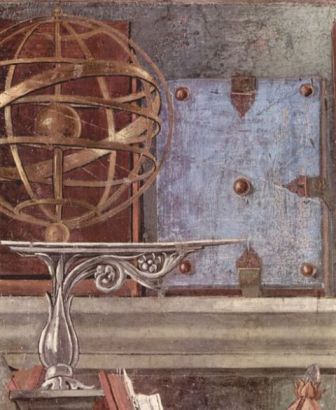 This is quite interesting. Other names for the Armillary Sphere are: astrolabe, spherical astrolabe, armilla, or armil - Wikipedia. Armillary derives from armilla latin for (circle or bracelet) - Wikipedia. The Armillary Sphere is a celestial navigation tool. Both the Greeks and the Chinese had simple Armillary Sphere models before the time of Christ (BC or BCE). Pictured is a Sandro Botticelli (more known for his famous Nude in a Clam Shell) painting with an Armillary Sphere
This is quite interesting. Other names for the Armillary Sphere are: astrolabe, spherical astrolabe, armilla, or armil - Wikipedia. Armillary derives from armilla latin for (circle or bracelet) - Wikipedia. The Armillary Sphere is a celestial navigation tool. Both the Greeks and the Chinese had simple Armillary Sphere models before the time of Christ (BC or BCE). Pictured is a Sandro Botticelli (more known for his famous Nude in a Clam Shell) painting with an Armillary Sphere 
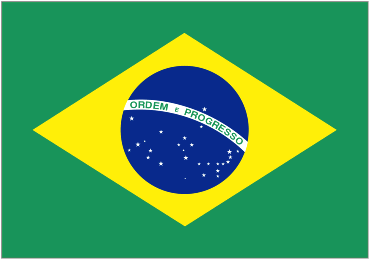
Famous Portuguese Explorers
The Portuguese were Explorers. Some famous, known, Portuguese explorers follow.- Henry the Navigator, 1394 - 1460:
- Encouraged his father to conquer Ceuta (1415), the Muslim port on African side of the Straits of Gibraltar, also a pirate base who made Portuguese Slaves
- Saw the possibility of bypassing the Mediterranean land/sea trade routes to Asia
- Brought African Slaves and gold to Portugal
- Member of the Oder of Christ (Knights Templar)
- Had charts made (hired cartographers, gathered/collected chart information
- Circumvented Muslim Sahara trade routes, circumnavigated Africa (as far as possible)
- Charted and explored much of the African Coast
- Rediscovered Madeira Islands, 1420, colonized in 1427
- Vasco da Gama (buried at Mosteiro Dos Jerónimos), 1460 or 1469 - 1524:
- Died in India
- Very successful
- Commander of the first ships to sail directly from Europe to India thus avoiding the Mediterranean land/sea trade route trade route controlled by the Republic of Venice
- 1497-8 Exploratory Journey to India (Explored from Southwest, South, and Southeast Africa to West India). Tried to find a friendly port in West Africa but ran into unfriendly Muslim sultans
- 1502-3 with Military and Naval reinforcements, set up bases and trade agreements
- 1524 for financial gain, conducted problem resolution, was granted Governor and Viceroy of India
- Ferdinand Magellan, (Fernão de Magalhães), 1480 - 1521:
- Sailed/Explored under Spanish sponsorship
- Found the Spice Islands of Indonesia
- First European to lead an expedition across the Pacific Ocean
- First to attempt to circumnavigate the Earth, killed in the Philippines but ship went all the way
- Found the Strait of Magellan, a protected inland passageway that avoids the rougher seas found at Cape Horn (Drake Passage)
- Elements used on ships: the armillary sphere (a navigational instrument and the personal emblem of Manuel I and also symbol of the cosmos), spheres, anchors, anchor chains, ropes and cables.
- Elements from the sea, such as shells, pearls and strings of seaweed.
- Botanical motifs such as laurel branches, oak leaves, acorns, poppy capsules, corncobs, thistles.
- Symbols of Christianity: such as the cross of the Order of Christ (former Templar knights), the military order that played a prominent role and helped finance the first voyages of discovery. The cross of this order decorated the sails of the Portuguese ships.
- Elements from newly discovered lands (such as the tracery in the Claustro Real in the Monastery of Batalha, suggesting Islamic filigree work, influenced by buildings in India)
- Columns carved like twisted strands of rope (this is not an original concept, as twisted columns can be found in the 13th-century cloister of Basilica of St. John Lateran, in Rome)
- Semicircular arches (instead of Gothic pointed arches) of doors and windows, sometimes consisting of three or more convex curves
- Multiple pillars
- Eight-sided capitals
- Lack of symmetry
- Conical pinnacles
- Ornate portals with niches or canopies
- Beveled crenellations (castellated battlements like square sine waves - Dennis)
- A linear element, a line, sometimes itself called a Manueline, which could be plain but was often represented as a rope or a vine, often 3 or 4 inches wide, that completely surrounds a door, window, or portal, or it could completely go around a room or even a building - Added by Dennis.
- The monastery was designed in the Manueline style by Diogo de Boitaca.
- The monastery withstood the Great Earthquake of 1755 without too much damage.
- The Church of Monastery is called Santa Maria.
- There is a statue of Baby Jesus, Mother Mary, and her mother Saint Anne (Santa Ana or Santana)
- White Grape Vine in far Left Image.
- Red Grape Vine in Center Image.
- Mixed Red and White Grapes and Vine in far Right Image.
Manueline Architecture
Jerónimos Monastery
Quoting Wikipedia:
The house for the Hieronymite monks was built on the same site of the Ermida do Restelo, a hermitage that was founded by Henry the Navigator at about 1450. It was at this hermitage, that was already in disrepair, that Vasco da Gama and his men spent the night in prayer before departing for India in 1497.
The existing structure was started on the orders of Manuel I (1515-1520) to commemorate Vasco da Gama's successful return from India. It was originally meant as a church for the burial of the House of Aviz, but it also became a house of prayer for seamen leaving or entering port.
Construction of the monastery began in 1502 and took 50 years to complete. He used pedra lioz, a local gold-coloured limestone, for its construction. The building of the monastery was funded by a 5% tax on eastern spices, with the exceptions of pepper, cinnamon and cloves, revenue from which went straight to the Crown. By this influx of riches, the architects had enough financial margin to think big. The enormous amount of funds needed for this monastery, meant abandoning the construction of the Aviz pantheon in the Monastery of Batalha.
Above Left: Church of Santa Maria.
Above Right: Courtyard of St Jerónimos.
Above Left: The Chancel of Santa Maria. King Manuel had a few wives. Going against the wishes of the King and the other Wives, the last surviving wife, Queen Catherine of Habsburg, built the Chancel as she wanted it. It contains the tombs of the royal family (including herself). The Chancel is built in a 'Classical Style' (not a Manueline or Late Gothic Style) - To Queen Catherine's credit, this architecture marked the beginning of the Renaissance Style of architecture.
Above Right: See the Knights Templar symbol?
Above Left: See the Knights Templar symbol?
Above Right: See any Knights Templar symbols?
St Jerome (347-420 AD), thought to be of Illyria (the Balkan area between Italy and Greece) was a well educated and a well traveled man, is credited for translating the bible into Latin. He spoke and wrote Greek and Latin and is considered a Doctor of the Church (as in Doctorate). His translation included Hebrew sources while other previous translations were just from Greek. He was a Christian Apologist. Apologist's "present a rational basis for the Christian faith, defend the faith against objections, and expose the perceived flaws of other world views" [Wikipedia].
The St Jerome LION Story If the reader has ever heard the story of the man that removed a thorn from the paw of a Lion, it is supposed to be Jerome who performed this act. He apparently actually had a Lion as a kind of pet. The story goes that Jerome was entering a Hermitage/Monastery when all the students/initiates were seen running out of the building. They told Jerome that there was a lion in the Monastery. Jerome entered the building to investigate and, long story short, removed the thorn from the paw of the lion. From then on, the lion hung around the Monastery, and eventually became an item of the Monastery. Many paintings of St Jerome show a lion in the foreground.
Tower of Belém
Belém is a community area, west of Lisboa, and includes the Jerónimos Monastery with the Santa Maria church and the Monument to the Discoveries - All within 400 meters of one another. The 'Tower of Belém' was "built to commemorate Vasco da Gama's expedition and remains a reminder of the maritime discoveries that laid the foundations of the modern world. North African influences can be seen on the upper parts. The tower was built in 1515 as a fort in the middle of the Tagus River". The Great Earthquake of 1755 moved the river, such that the Tower Fort is now on the North bank of the Rio Tagus. Remarkably, the Tower is virtually undamaged.
Above Left: Canon Deck.
Above Right: Stern Castle (literally).
Monument to the Discoveries
Padrão dos Descobrimentos (Literally: 'Monument to the Discoveries'):"The monument consists of a 52 meter-high slab of concrete, carved into the shape of the prow of a ship. The side that faces away from the river features a carved sword [and symbolic cross - Dennis] stretching the full height of the monument. It was conceived by Portuguese artists, architect Cottinelli Telmo and sculptor Leopoldo de Almeida as a temporary beacon of the Portuguese World Fair in 1940. The Monument to the Discoveries represents a romantic idealization of the Portuguese past that was typical during the regime of Dictator Salazar." - Wikipedia.
Henry the Navigator leads the congress. More or less, one side is for Sailors, Navigators, and Military Leaders while the other side is for Scholars, Chart Makers, Nobles, and Religious Leaders.
A picture of the Discoveries Monument is typically what is on the cover of Portugal Tour Books.
The compass rose and world map showing different Portuguese Discoveries is a donation from South Africa.
Castle of São Jorge
Archeological findings at the site demonstrate habitation since 600 BC. Since then Celts, Iberians, Phoenicians, Greeks, Carthaginians, Romans, Suebics, Visigoths, and Moors have been tenants and each occupier added a little more defensive fortification. Around the 11th Century Crusaders (financed by the Knights Templar) under the leadership of King Afonso Henriques, took the castle from the Moors. In a well told war story, the knight, Martim Moniz, noticed that one of the doors to the castle was open, and he prevented the Moors from closing the door again by throwing his own body into the breach, costing him his life but winning the battle.
Using the castle in the 12th century, a Moorish re-insurgency was repelled. As a result of the stronghold, Lisboa became the Capital and major City of the area and eventually of Portugal. In 1300, King Denis I renovated the Castle. In 1373-5 a fortress wall was build around the city, some of which still remains. In the late 1300's King Joãn I renamed the castle, to its present name, for his bride Princess Philippa of Lancaster, England. Until the 16th Century the tower was well used and well maintained.
At the height of Portugal's economic period of discovery King Manuel I built a Royal Palace in the Belém area along the side the Tagus River. This Palace has been used by Rulers ever since and the condition of Castle São Jorge has deteriorated ever since. There have been attempts at restoration but changes of priorities have always prevented completion. Earthquakes in 1531 and 1755 damaged the castle dramatically.
Baixa (Downtown Area), Rossio, Pedro IV Square
Rossio means 'Large Square' and actually the downtown area has a couple long malls and three or four adjacent squares separated by one city block. Generally 'The Rossio' is considered to be the Pedro IV Square. This area has been a meeting place for centuries. We ate there every night. Most restaurants don't open until 2000 hrs and we learned this may be because of the heat. People just don't feel like eating until its cooler, which seems to be about 8 PM. We were in Lisbon in the second week of September and each day got as high as 35° or 36°C (95-97°F).Lisbon Area
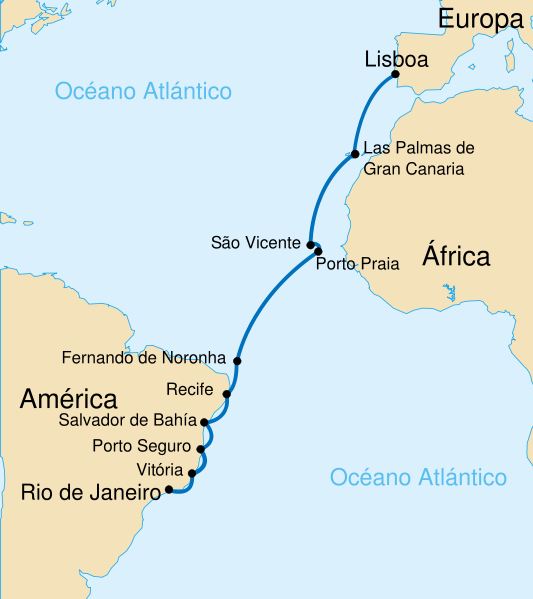
The '25th of April Bridge' was created by the same designers as the Golden Gate Bridge (in San Francisco, California), but it is not a copy. For example, the Portuguese version has cross supports in the trestles where the golden gate has none.
The Statue of Jesus is a smaller duplicate of the statue in Rio de Janeiro.
Above Right: Sarmento's, Jewry since 1870. It's at the base of the Santa Justa vertical elevator. We contributed to their longevity.
Sintra, Portugal
The village of Sintra contains, apparently, two National Palaces, one known as the Sintra National Palace or Town Palace or Summer Palace and the other known as Pena National Palace. The town of Sintra was originally a Moorish Stronghold with a Castle and Fortifications on the top of the mountain called 'Castelo dos Mouros'. We got to see the Town Palace.The origins of the Town Palace probably started with the Moorish occupation in about 1000 AD. King Afonso Henriques took possession after running the Moors out of the region. Subsequent construction is mixed Gothic, Manueline, and Renaissance (added to a Moorish base). The Palace represents different architectures and accoutrements fitting different styles through the centuries.
Cascais and the Ocean
Cascais is on the coast and is about 30 Kilometers West of Lisbon (also Sintra is about 10 Kilometers to the north [inland]). It is a traditional summer resort town within easy train or car travel from Lisbon. Cascais started as a maritime town but has in now trendy with many homes from Jet Setters and International Nobility (many that were exiled from their home countries since WWII).The town has a casino named Estoril Casino. Interestingly, with Portugal being neutral in WWII, spies from the Axis and from the Allies kept an eye on each other in this town at Estoril Casino. One of the Embassy Staff members from the UK was named Ian Fleming; perhaps his experience in Cascais gave him the idea for his book 'Casino Royal'. Also, scenes from a James Bond movie, On Her Majesty's Secret Service, were filmed in this area.
Conference Dinner at x
Tiles in Portugal
Fado
Fado means Destiny or Fate, and it is Portuguese Music that is mournful in tune and lyric. The source seems to be a mix of Moorish and African. The subject can be anything but the more known lyrics are about lost love. We went to a Fado Cabaret for dinner and music.We never learned the significance of the Axe (Machado means Axe).
Road Trip (Lisbon > Viseu > Porto)
Day 1
Above Right: Roman City of Conimbriga in Roman Provence of Gallaecia near Coimbra, Portugal. There is only now a sense of discovery that this was a large city of about 10,000 people during the days of the Roman Empire.
Viseu
Viseu is the largest city in the Dao wine demarcation. The city square has a local life, from about a hundred years ago, depicted on tiles which are on a street ramp wall.Mosteiro de Sao Cristovão de Lafoes
The Cistercian Monastery is a 12th Century Tuscan Style Cloister that was purchased by Portuguese Couple and converted into a Bed and Breakfast Inn. Modern accoutrements were added but the original theme of simple life is still maintained. The Church on the property still serves the community.Day 2
Casa de Santar
Oh Boy, we were going to be late.We set up a guided tour months ago while still in the USA. The Wine Tour Escort is coming in on her day off, just for us. We called, but could only leave a message. We could not find the Winery or Sales Office. We stopped at the fire department and asked for directions. The Fireman stepped outside to point to a white house. So we were looking for a white house. First of all, everything is white. Second of all we don't see a house, we see what looks like a series of townhomes next to the street, we did not see anything that looked like a traditional wine shop or winery.
We missed it again. It turns out that what we were looking for was the mansion home of the Contessa of Santar whose family has been in the Village of Santar since 1790 (this is not her proper title but she is a Contessa of Portuguese Royalty and the title goes back to the 1700's Duke who was a merchant in South Africa). Like most gated and walled properties, no one takes care of the outside. There was no indication, to us, to make us think that all of these seemingly side by side looking structures were one house. We came back and only by coincidence (or divine intervention) we parked in front of the main gate to the property. The guide came out to greet us and we apologized to no end; she too was feeling abandoned, it was her day off, we were one hour late.
Above Right: We explain our lateness and apologize while stepping through the gate. Inside the gate, this is what we see. Katiya explains the environment and situation to us. She was about to leave and she never got the message that we left for her. She states that all the problems are behind us now and we are to enjoy the tour. We sure did.
Our guided tour includes the house but not any personal areas. We got to see the family Chapel with relics of Saints, an old gilt laden carriage, and a personal sedan (to be hand carried by footmen), horse tack from different time periods, a well worn side saddle, and a large kitchen area that contains a natural spring fountain that has been used to supply the town with water when there was a need.
Above Right: A wall plaque in the wine store reads Casa de Santar, One Family, One Passion. Note the design of the house, that is an exact replication!
Above Right: Fountain with Coy.
Above Right: French Oak Barrel aging and storage.
Along the way, we have learned that the family estate's winery process and services are provided to the entire Santar community - House of Santar is the community winery, selling some of it's own brand, some brands of other local vineyards, as well as pooling the grapes for one large community winery. They meet the demands of the Domain of Control and sell under different labels. Our Dao red wine of the Casa de Santar, that we bought and brought home, was the best wine that we have ever tasted, period. They also make a sparkling wine and we are waiting for New Year's to try it.
Above Right: A few of the products of Casa de Santar.
The Bicycle Tour
to and through the Douro River Valley
Day 1: Porto Train to Pinhão,
Then pedal a loop through Sabrosa back to Pinhão.
We stayed in Porto for the night, turned in our rental car, uncased the bikes and put them together for an early morning departure - no time to be tourists in Porto.Above Right: We've gone through three stops already.
Above Right: Now we're on the correct train and it has a cargo hold / bicycle bay.
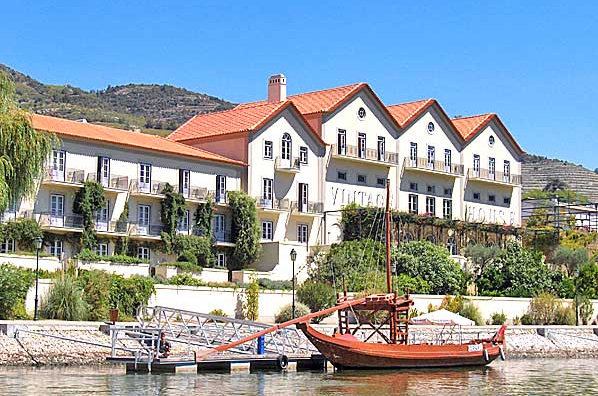
Above Right: Our Hotel, Vintage House.
Above Right: Just out of town and pedaling up hill. This operation has a large investment in terracing (Rio Douro). The grapes have already been picked.
Above Right: Now we're seeing grapes on vines. Terry see's a perfect vision for a photograph and she has Dennis stop and hold the bike. Terry goes back about 30 meters and takes this picture. What an eye!.
We soon discover that the grapes are first ready at the river level and the grapes begin ripen from the river first and then slowly towards the top of the hill. The grapes do no all ripen all at one on one hillside. This gives the owners a way to methodically spread the grape picking effort over a longer period of time. By the way, when it's time to pick grapes, everyone helps, especially families of owners. Sometimes kids run shops while the parents are working on the hill side(s).
Above Right: A close up of a bucket of picked grapes. If anymore are stacked, then the bottom grapes begin to split open. The smell of grape juice is everywhere and it is pleasant.
Above Right: We are about to cross our first hill crest. We discover that the Domain of Control changes from the Douro Demarcation to the Alto Douro Demarcation. We learn later that there is some similarity between The French 'Haut' Zones and the Portuguese 'Alto' Zones. It is a lot cooler up here. We've been cycling uphill with our backs to the sun. The shade of the trees is feels refreshing.
What is the temperature you ask? About 35°C or 95°F. Yeah, it's a little warm but humidity is not high. The famous Douro Terio (French Terroir) exists because of the hot dry climate.
Above Right: Olives. Now we're seeing grape fields bordered by olive trees.
Above Right: Hills of Portugal, what joy, we're having fun and staying cool!
Above Right: We are finally seeing Bronca (White) Grapes. Until now, all grapes were red.
Above Right: Another village's Wash House. Clean Spring Water comes out a spigot (at the far right back), then there is a little tub for more clean water (for horses or such), then that water runs into the big pool (used for washing). This concept dates back to Roman Empire times.
Above Right: Actual childhood home of Ferdinand Magellan. Cool Huh? Ferdinand's ship was the first ship ever to circumnavigate the world. Ain't that awesome? Before this time, ships would fall off the end of the world. Arh arh. Magellan did not make it with the crew; he was killed in the Philippines.
Not to be outdone, England's Captain Cook was killed by Hawaiians. What is it about these Pacific Islanders? [We have Portuguese, Hawaiians, and Filipinos in our families - We're yanking their chain! They're fun people.]
Above Right: Red grapes, unloaded at the dock, waiting for step one, de-stemming.
Above Right: The town of Pinhão and the Rio Douro. Due to good planning on the person who set up this Self Guided Tour for us, Catherine Deffense [of Cycling through the Centuries], Home is a downhill run! Good planning for after tossing back a few glasses of Port!
Oh, in case the reader missed it, this is our first ever recommendation for a bicycle travel tour - It does not have to be our Douro Valley tour, it can be any tour by this company, Self Guided or Guided.
Above Right: The view from our room's window. Tomorrow we cross that bridge and climb up to Pesqueira.
Day 2, Pinhão to São João da Pesquiera
Above Right: Back view of hotel and Pinhão, as we depart.
Above Right: We take break in a small village.
Above Right: Bought some fruit (Peaches), now we are directed to the bread shop.
Above Right: Mid-Afternoon: we arrive at our next destination, Hotel Pesquiera, for the night. We have the first spare time together since arriving almost ten nights ago. Dennis decides to get a bicyce 'Thump' noise checked out at a local bike shop. Terry checks the local markets for gifts and post coards.
Funny Story: First of all, it is nice that a Bicycle Shop is indicated in this town by our Self Guided Tour Map of the city. Dennis is going to rat himself out.
We assembled the bikes two nights ago, very late and we were exhausted. So Dennis goes to a Bicycle/Motorcycle Shop, the only one in town. They don't speak a word of English, Dennis knows fifty words of Portuguese. Dennis offers the Olá greeting and they look at Dennis like with expressions that indicate that 'This is going to be interesting'. These guys have never seen a tandem bicycle before, but it won't matter. Dennis makes a pedal motion with his hands. They get it. Dennis utters the word Thump, at the top of each right hand's cycle. They get it. The bike tech wanders to the bike and looks at the front crank. He makes one rotation and points the Pump (mounted on the frame). He points in and out at the pump. Dennis has a look of, you've got to be kidding on his face. Dennis removes the pump and takes the bike on a short test ride. No Noise. Dennis comes back with a sheepish face and says the word 'Euro' and makes the international finger rub motion that indicates Money Bills. The Shop Tech gives the international wave-off sign for 'Forget-About-It'. Dennis puts his hands together in Buddhist Prayer fashion, bows, and says Obrigato (Thank You). They respond Da Nada.Meanwhile, Terry has to go to the Meat Market in order to buy Post Cards. Go Figure.
Above Right: Art inside the Government Building.
Above Right: Sunset for our Dinner. Early to bed for both of us for a well earned extra long sleep. Breakfast is not served until 0800.
Experience: In Countries and B&B's where breakfast is typically served at 0800 or even 0900, we have learned to ask, the evening before, for a breakfast bag to go. Usually we get a sandwich or the materials to make a sandwich and some fruit.
Experience: Getting up early and bicycling in the cooler time of the day is smart cycling. This is especially true in Hot countries (like Portugal, Spain, or Italy - Countries that have Siestas for a reason, it's too Hot at the high sun hours to be working in the sun light).
Day 3, Pedal to Vila Nova de Foz Côa via N222 and many Interesting Villages
Above Left: Terry spots another gem of a picture. Red Douro Grapes with early turning leaves.
Above Right: Casa dos Leos.
Above Right: A distant village seen trough an Agabe plant. Not many grapes now.
Above Right: Another bus shelter. It's bomb proof.
Above Right: I know that it is sophomoric, but still. It is actually another agricultural zone of demarcation.
Above Right: We're at the same spot, off the road. Terry has cooled down and is cold; she needs to stand in the sun. This is as cool as it ever gets.
Above Right: We're at a tight turn in a three way intersection on hill side - It's dangerous for fast moving cars. The mirror helps drivers see other vehicles in the otherwise blind spots. For us, this makes for an interesting opportunity. See if you can see the 'Bee' (name of our bike). The greenish town crest (tile on a local water trough) on the left side of the mirror is the very next picture.
Above Left: We recognize Olives on the right side and Grapes in the middle. We try to intuit that the plant on the left is almond related, but it is more like Lavender. We never discover the answer. Anyone know? See the spigot?
Above Right: Here is a (fruit) tree grove with mixed Almond Trees and Olive Trees.
Above Right: Another one of those old fortresses. on a hill top. We never see the Douro River, but I bet that it can be seen on that hill top. This is as far north as we go today, now we will slowly head back (south) towards N222 and eventually enter into a very fertile valley.
Above Right: Restaurante Quinta. I don't know the name of the village but it's at the intersection of N222 and the road that heads north to the village of Numão. This was just another roadside stop, until Dennis went to the bathroom, but I'm getting ahead of myself. This is a first class Restaurante.
Above Right: A happy camper (Terry).
Above Right: That's the same vine growing out the outside of the Restaurante. The proprietor was already waiting for me; he was thoroughly enjoying himself and watching my surprise as I was explaining all of this to Terry. More >>
The following is what we think that the proprietor is stating:
The vine that comes out of the Men's Room is a Branca (White) Grape Vine. There are already other Rosa (Red) Vines growing beside the parking lot. They use and allow the grape vines to grow through a latticed overhead cover in the parking lot as shade [see three image rows previous], also the lattice is visible in the above images. Somehow, the White Vine graphed itself onto a Red Vine (or visa versa) and the result produced a grape bunch that has mixed Red and White grapes.Fact: Dark Red, Black, and Blue Grapes are all considered to be in the Red Grape Family
(for viticulture purposes).
Above Right: Sometimes a scene just says 'Take my Picture'.
Above Right: This is our place of stay, an Agriturismo called Quinta Chão d'Ordem. The owners are many generations of family that go back to Knights Templar or Knights of Christ. This establishment used to be a way station for traveling Knights. There are ancient documents posted on the wall.
For the record, Dennis has showered and is wearing the next day's clothes for dinner tonight. Dennis is about to relocate the bike for weather protection.
Above Right: Terry is joined by o gato in a brief break beside the dorm and pool.
Day 4, Round Trip through Marça, Mós, and Pocinho
Above Right: Well, we just climbed straight up about 5K. At the 'Y' intersection at the top of the hill we either turn left (west) for Pesqueira (where we came from yesterday), or we turn right (north) for Marça, Mós, and Pocinho. This sign is pretty much our itinerary today.
Above Right: Collection point with mixed sized grape containers.
Above Right: Our Good Turn for the day. See the spilled buckets at the end of the road. It is obvious that they fell off a truck on the curve. We collected them and set them at the road side. Da nada.
Oh yeah, that's Marça in the back ground.
Above Right: Downhill Miradouro.
Above Right: Marça.
Above Right: A harvest worker is delivering grape buckets to a hillside that is too narrow for a vehicle. We are entering Mós. The village has speakers playing a kind of Portuguese Hip Hop.
Above Right: We cleared the hill top and we're ready for a snack break.
Above Right: A pastoral tile picture on the side of a casa in Santo Amaro.
Above Right: We were 'Riding through the Centuries', what they call Olive Trees that are over 100 years old. Pretty neat, huh?
Above Right: The Estação Ferroviária (Railroad Station) of Pocinho.
Above Right: In case the reader ever wondered, this is where municipal street signs go to die (just entering Foz Côa).
Cool Incident: Within Foz Côa, while pedaling downtown on a cobblestone road; we passed by a school yard of pre-schoolers. Dennis was negotiating the cobbles so Terry saw this incident all the way through. Terry looked out and saw a Teacher pointing toward us. Some kids turned to look. Terry waved and said Olá loudly and those kids simultaneously yelled Olá and started running to the fence, waving. Then, all of the other kids in the school yard (maybe 60 in total) turned to join in. Very quickly, all the kids were hanging over a short stone wall or standing at a chain-link fence yelling Olá, Olá, Olá. We waved back and they cheered. It must have been quite a sight to see two Americano's (anyone) on a Tandem Bicycle pedaling through the town.
Above Right: A Clinic for Miserable Conditions.
Day 5, Quinta Chão d'Ordem to
Pinhão by way of Parque Arqueológico
(Ancient Rock Art in Inferno Canyon)
Above Right: We bought this bottle of Bronca Port from the Proprietors, just before we departed. The stone label goes with the theme of the ancient rock art in this area. The port is great.
Above Right: This is the Park Headquarters. Terry is in the foreground putting on sunscreen.
We will catch a ride in a 4x4 vehicle with an English speaking guide. There are four or five rock art sites. The Rock Art access is protected and available only through reservation or appointment. Our Self Guided tour hostess set this up for us. We will be attended by four Germans (most who speak English), and one Belgian (who speaks English and was originally going to be here on bicycle, but the booking process got messed up for him).
Above Right: Descent into Inferno (Hell) Valley. All of the jackets and sweaters came off in about 10 more meters.
Above Right: Horses.
Above Right: Beautiful Blue (Azure) Tile Art Work about Grape Collection on the wall of Pocinho Station.
Above Right: Terry is relaxed and waiting for Dennis to sit down.
Above Right: A typical Railroad Depot and a One Minute Stop.
Above Right: A Port-Wine River Barge converted to a river ferry boat. We were supposed to ride one of these Barges downstream, back to Porto. It would have been relaxed and romantic but it takes seven hours and does not leave Pinhão until 0900 (it puts one into Porto at Rush Hour and one still has to get from the boat to their place of stay). At the last minute, we decided to return to Porto on a train with a three hour total ride time.
Day 6, Ride Train from Pinhão to Porto
Above Right: A typical river view for quite a while. As we neared Porto, we left the company of the Douro River.
Above Right: Sophisticated Tiles on another former Merchant's House.
Above Right: Another Porto downtown street scene (in the old city).
Lesson: When one has four bags of luggage, and one has the hotel pre-arrange a Taxi pickup time, REMEMBER to request a Taxi large enough to carry four bags and two people.Above Right: We are safely at home. We are going to a casual neighborhood get-together. The flowers are from our yard and the wines are hand carried from Portugal; Douro White Tawny Port (Quinta do Portal) and Dao Red (Casa de Santar), Yum!